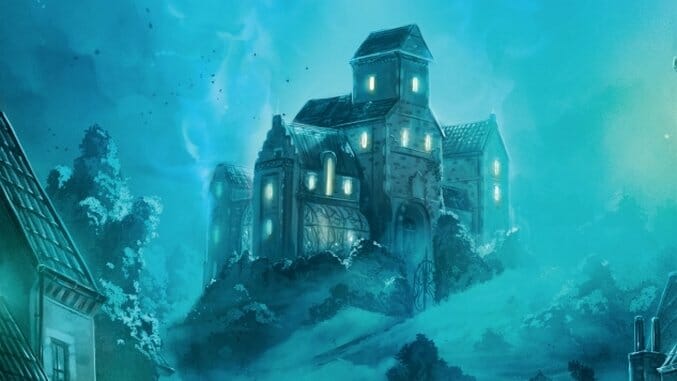Mysterium is an Imaginative Matching Game with a Ghostly Twist

The cooperative boardgame Mysterium first appeared in Polish (Tajemnicze Domostwo) in 2013 and acquired a small following outside of eastern Europe thanks to an online translation of the rules into English, eventually spurring a reissue of the game with the new title and slightly altered rules in October of 2015. Fantasy Flight Games, the English publisher, has since added an expansion called Hidden Signs that adds new cards to the game’s various decks, but the game itself remains intact—and unlike any boardgame, cooperative or otherwise, I’ve come across, because so much of the game involves the players’ imaginations.
In Mysterium, one player plays the role of the dead guy … okay, the dead guy’s ghost, but it sounds better the first way. The ghost must try to communicate to the other players, who are psychics called to the mansion where the murder took place, who killed him, where and with what object. The ghost can only do so using “visions,” represented by cards that have the weird, unrealistic qualities of dreams, with items and scenes that don’t clearly go together. The vision cards should remind the psychics of something on the card representing the correct suspect, room or object for that specific psychic—each player-psychic has a specific combination of three that s/he is responsible for identifying before the players work together to identify the actual culprit. Players get seven rounds to try to guess all three of their cards, visible only to the ghost-player, and only work on one of the three at a time, first guessing each of their suspects, then the locations, then the objects.
The vision cards are the key to the game because, while they’re beautifully rendered, they’re about as strange as … well, my dreams, for one thing. A man flying an old-timey velocipede lofted by balloons over a pastel-colored village. A diminutive white-haired man, holding a diamond, running down a hall away from a spectral knight, a painting of a queen shooting a gun at him, and two dogs straining at their leashes to leap from their painting to catch him. A door, slightly ajar, with two open books floating in mid-air above a paper airplane. And so on. The idea is that the ghost-player sees something in each vision card that connects to the card that particular psychic (to whom he deals one or more vision cards on each turn) is trying to guess—an object on the target card, the function of the room or object, or the occupation of the suspect.
-

-

-

-

-

-

-

-

-

-

-

-

-

-

-

-

-

-

-

-

-

-

-

-

-

-

-

-

-

-

-

-

-

-

-

-

-

-

-

-









































